 National Geographic’s 2011/2012 special edition "Journeys of a lifetime - 500 of the World’s Greatest Trips"
distinguishes Sifnos by giving it the 9th spot in the Top Ten list of "Islands Under the Sun" !
National Geographic’s 2011/2012 special edition "Journeys of a lifetime - 500 of the World’s Greatest Trips"
distinguishes Sifnos by giving it the 9th spot in the Top Ten list of "Islands Under the Sun" !
Here is an extract from this special edition:
"Spots in the ocean that someone could hardly notice on a map.
Yet if you find yourselves there, you’ll know there’s no other place of equal beauty in the whole world."...
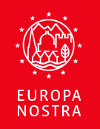
Sifnos
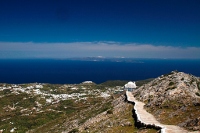 is one of a group of 6 small islands forming the Western Cyclades. The appeal of Sifnos, for Greek and foreign
visitors alike, is due to its successful retaining of traditional ways of life, its removal from the beaten track of
mass-tourism, its turquoise beaches and the historically unspoiled settlements, churches and monasteries found here.
Sifnos is well known for its food as well, and many world famous chefs have come from this small island.
is one of a group of 6 small islands forming the Western Cyclades. The appeal of Sifnos, for Greek and foreign
visitors alike, is due to its successful retaining of traditional ways of life, its removal from the beaten track of
mass-tourism, its turquoise beaches and the historically unspoiled settlements, churches and monasteries found here.
Sifnos is well known for its food as well, and many world famous chefs have come from this small island.
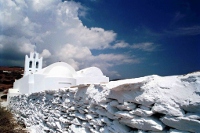 The island is unspoiled by any modern architecture, and is threaded with ancient footpaths that wander through the
foothills to the island’s many small white churches and monasteries, and ancient ruins. Tourism hasn’t touched this
island in the way it has other Cycladic islands such as Santorini and Mykonos, so there are no sea sports or activities
for hire; instead there are tavernas offering home cooked Greek and local delicacies on the beautiful sandy and rocky
beaches of the island alike, and good café culture. The main village of the island, Apollonia, has pedestrian marble
paths off which all the island’s nightlife and many great tavernas are located. The hills of the island create panoramic
sea views everywhere you go, with sheep and goats roaming in all the pastoral views. It may sound like the archetypal
Greek island, but not many of them are as Greek an island as this island is, which is part of Sifnos’ appeal.
The island is unspoiled by any modern architecture, and is threaded with ancient footpaths that wander through the
foothills to the island’s many small white churches and monasteries, and ancient ruins. Tourism hasn’t touched this
island in the way it has other Cycladic islands such as Santorini and Mykonos, so there are no sea sports or activities
for hire; instead there are tavernas offering home cooked Greek and local delicacies on the beautiful sandy and rocky
beaches of the island alike, and good café culture. The main village of the island, Apollonia, has pedestrian marble
paths off which all the island’s nightlife and many great tavernas are located. The hills of the island create panoramic
sea views everywhere you go, with sheep and goats roaming in all the pastoral views. It may sound like the archetypal
Greek island, but not many of them are as Greek an island as this island is, which is part of Sifnos’ appeal.
Kamares
is located in a deep bay. This is where the boats arrive and depart from, but we don’t like to use the word
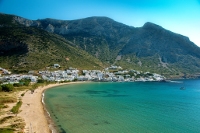 harbor because this may paint a different picture from the accurate one, which is really of a small village on a long
sandy beach. This sandy beach has actually been awarded in 2002 with a Blue flag for its cleanliness. There are many
tavernas, cafes, pubs and shops here as well as many traditional ceramic workshops. Best of all in Kamares are the beautiful
sunsets and the sea side restaurants and cafes. Kamares is the only area in Sifnos that combines the beach for the day
and restaurants and cafes for the nightlife. An excellent bus service links Kamares to the beaches on the other side of
the island and the main village of Apollonia in the center of the island. The southern beaches of the island
(Platy Yialos, Faros, Chrysopigi, Vathi) are at a distance of 12-15 km. Apollonia, the capital of the island, is 5 km.
from Kamares. The community of Agia Marina belongs to the village of Kamares and it is located at the far end of the beach.
Agia Marina community is a very quiet area that has two tavernas and two cafes and the distance to Kamares center is 700 m.,
which is actually the length of the beach.
harbor because this may paint a different picture from the accurate one, which is really of a small village on a long
sandy beach. This sandy beach has actually been awarded in 2002 with a Blue flag for its cleanliness. There are many
tavernas, cafes, pubs and shops here as well as many traditional ceramic workshops. Best of all in Kamares are the beautiful
sunsets and the sea side restaurants and cafes. Kamares is the only area in Sifnos that combines the beach for the day
and restaurants and cafes for the nightlife. An excellent bus service links Kamares to the beaches on the other side of
the island and the main village of Apollonia in the center of the island. The southern beaches of the island
(Platy Yialos, Faros, Chrysopigi, Vathi) are at a distance of 12-15 km. Apollonia, the capital of the island, is 5 km.
from Kamares. The community of Agia Marina belongs to the village of Kamares and it is located at the far end of the beach.
Agia Marina community is a very quiet area that has two tavernas and two cafes and the distance to Kamares center is 700 m.,
which is actually the length of the beach.
Apollonia
(island’s capital) is an unspoiled traditional town, renown for its magnificent architecture. Staying here puts one in the
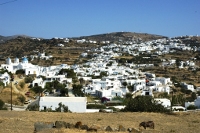 heart of Sifnian life. Apollonia has a very active nightlife, which is nice to be near-by, nevertheless, hotels and pensions
in the area are mainly on quiet footpaths. In Apollonia there are many great tavernas, all the island’s facilities and a general
feeling of the island life. Most of the town is situated off small old footpaths, minimizing traffic disturbance and creating
a timeless feel to the town. This is a nice place to explore the island by foot from, as there are lovely footpaths that begin
in Apollonia and go through the hills to remote monasteries and high points for views of the entire island. The island’s bus
services always pass through Apollonia so it is easy to get to the outlying beaches from here (a 15 minute bus ride to any beach).
heart of Sifnian life. Apollonia has a very active nightlife, which is nice to be near-by, nevertheless, hotels and pensions
in the area are mainly on quiet footpaths. In Apollonia there are many great tavernas, all the island’s facilities and a general
feeling of the island life. Most of the town is situated off small old footpaths, minimizing traffic disturbance and creating
a timeless feel to the town. This is a nice place to explore the island by foot from, as there are lovely footpaths that begin
in Apollonia and go through the hills to remote monasteries and high points for views of the entire island. The island’s bus
services always pass through Apollonia so it is easy to get to the outlying beaches from here (a 15 minute bus ride to any beach).
Artemonas
is a beautiful old village with traditional Cycladic architecture interspersed with impressive Neo-classic mansions. It is the
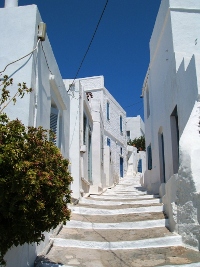 most traditional village of the island with over 100-year-old pastry shops and bakeries. It is the island's largest villages
although also the quietest one, since it is almost "a pedestrian only" village. From Artemonas the views of the sea and of the
hill side villages are wonderful. Also, Artemonas is connected by footpath to the main village of Apollonia (a 15 minute walk)
so one is not too far from all the islands facilities (banks, market, restaurants, post office, and nightlife). This is also
where the bus service begins and ends so it is an easy spot from which to explore the island by bus or to get to the outlying
beaches from here (a 20 minute bus ride to any beach). As many of the island’s walking paths are based around Artemonas it is
also a great spot for exploring the island by walking.
most traditional village of the island with over 100-year-old pastry shops and bakeries. It is the island's largest villages
although also the quietest one, since it is almost "a pedestrian only" village. From Artemonas the views of the sea and of the
hill side villages are wonderful. Also, Artemonas is connected by footpath to the main village of Apollonia (a 15 minute walk)
so one is not too far from all the islands facilities (banks, market, restaurants, post office, and nightlife). This is also
where the bus service begins and ends so it is an easy spot from which to explore the island by bus or to get to the outlying
beaches from here (a 20 minute bus ride to any beach). As many of the island’s walking paths are based around Artemonas it is
also a great spot for exploring the island by walking.
Kastro
is the island's most historical village built on the summit of a small peninsular hill and surrounded with views of the Aegean
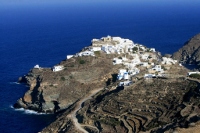 Sea. Until the 19th century Kastro was the island’s capital and its significance as a defensive town designed to protect its
inhabitants from marauding pirates is visible today in its uniquely fascinating architecture. It is a village with a 4000 year
old history and remnants of its heritage are visible everywhere. Part of its defensive wall was built about 800 BC. This remarkable
village is surrounded on three sides with views of the Aegean Sea. This charming all pedestrian village has a small selection
of cafes and restaurants. Its rocky seashores are popular with swimmers who prefer its large flat slabs of stone. It also has
a small pebble beach named Seralia at the foot of the hill (200 m.) accessible by foot. For "light" trekking lovers there is
a nice footpath that goes from Kastro to Poulati. To reach the lovely monastery of Poulati and its small rocky spot for swimming,
it is a beautiful fifteen minute walk along the coast. The popular southern beaches of the island are accessible by bus and
they range from 7 to 13 km. from Kastro. Apollonia, today's capital, is only 3 km. away.
Sea. Until the 19th century Kastro was the island’s capital and its significance as a defensive town designed to protect its
inhabitants from marauding pirates is visible today in its uniquely fascinating architecture. It is a village with a 4000 year
old history and remnants of its heritage are visible everywhere. Part of its defensive wall was built about 800 BC. This remarkable
village is surrounded on three sides with views of the Aegean Sea. This charming all pedestrian village has a small selection
of cafes and restaurants. Its rocky seashores are popular with swimmers who prefer its large flat slabs of stone. It also has
a small pebble beach named Seralia at the foot of the hill (200 m.) accessible by foot. For "light" trekking lovers there is
a nice footpath that goes from Kastro to Poulati. To reach the lovely monastery of Poulati and its small rocky spot for swimming,
it is a beautiful fifteen minute walk along the coast. The popular southern beaches of the island are accessible by bus and
they range from 7 to 13 km. from Kastro. Apollonia, today's capital, is only 3 km. away.
Cheronissos
is a quaint and charming traditional fishing village resting on a small sandy beach in a horseshoe shape around the narrow bay
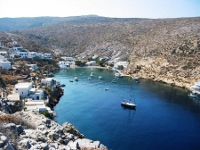 with turquoise waters. It is the smallest village of the island and most isolated and tranquil, originally a traditional settlement
of potters, now mainly a fishing village with only one pottery workshop remaining. One can always find fresh fish from the
returning fishermen with their catch of the day, as well as fresh local produce from the many small farms in the area. The village
of Cheronissos is at the northernmost part of the island which is 15 km away from the capital village (Apollonia) and 20 km away
from the port (Kamares). It is accessible to the rest of the island by a paved road and there are regular bus services to Apollonia.
with turquoise waters. It is the smallest village of the island and most isolated and tranquil, originally a traditional settlement
of potters, now mainly a fishing village with only one pottery workshop remaining. One can always find fresh fish from the
returning fishermen with their catch of the day, as well as fresh local produce from the many small farms in the area. The village
of Cheronissos is at the northernmost part of the island which is 15 km away from the capital village (Apollonia) and 20 km away
from the port (Kamares). It is accessible to the rest of the island by a paved road and there are regular bus services to Apollonia.
Platy Yialos
is said to be one of the longest beaches of the Cyclades and it is an excellent place for spending the day swimming in the water
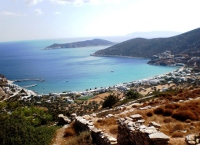 or playing beach games on the sand. It is also considered to be the cosmopolitan beach village of the island. There are many
sea-side tavernas and cafes here, a few pubs and mini-markets, as well as the most upscale hotels of the island. The distance
from Platy Yialos to the island’s capital village of Apollonia is 10 km. This area is accessible by paved road and there are regular
bus services from the port and from Apollonia to Platy Yialos.
or playing beach games on the sand. It is also considered to be the cosmopolitan beach village of the island. There are many
sea-side tavernas and cafes here, a few pubs and mini-markets, as well as the most upscale hotels of the island. The distance
from Platy Yialos to the island’s capital village of Apollonia is 10 km. This area is accessible by paved road and there are regular
bus services from the port and from Apollonia to Platy Yialos.
Faros
is a quaintly charming traditional fishing village resting on a sandy beach with turquoise water.
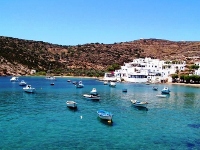 Within walking distance you can also find two more beaches: Glyfo and Fasolou. It is considered and idyllic spot for families with children.
From here one can eat at the seaside tavernas, relax on the beach or take a walk to even another beach, Apokofto beach, and to the island’s
most theologically important and visually stunning monastery located on a rocky precipice in Chrysopigi. The village of Faros is 7 km away
from the capital village of the island (Apollonia) and 12 km away from the port (Kamares). It is accessible to the rest of the island by a
paved road and there are regular bus services to Apollonia.
Within walking distance you can also find two more beaches: Glyfo and Fasolou. It is considered and idyllic spot for families with children.
From here one can eat at the seaside tavernas, relax on the beach or take a walk to even another beach, Apokofto beach, and to the island’s
most theologically important and visually stunning monastery located on a rocky precipice in Chrysopigi. The village of Faros is 7 km away
from the capital village of the island (Apollonia) and 12 km away from the port (Kamares). It is accessible to the rest of the island by a
paved road and there are regular bus services to Apollonia.
Vathi
is a traditional fishing village with a beautiful long sandy beach set in a large bay with many excellent taverns and a few nice
 seaside cafes. The beach of Vathi has only been accessible by paved road for a few years, and accordingly it is less developed
and touristy than the island’s other beach areas. There is a traditional potter’s workshop here and a monastery in the middle
of the sandy beach. If one is looking for a beach holiday then Vathi is strongly recommended. Vathi is a beautiful old fishing
village emanating a feeling of remoteness, especially since cars are not allowed within the village. The tavernas are built right
up to the beach and generally have the catch of the day hanging in front. Located 10 km. away from the island’s main village of
Apollonia, and 15 away from the port (Kamares). There is a bus service connecting Vathi to the rest of the island.
seaside cafes. The beach of Vathi has only been accessible by paved road for a few years, and accordingly it is less developed
and touristy than the island’s other beach areas. There is a traditional potter’s workshop here and a monastery in the middle
of the sandy beach. If one is looking for a beach holiday then Vathi is strongly recommended. Vathi is a beautiful old fishing
village emanating a feeling of remoteness, especially since cars are not allowed within the village. The tavernas are built right
up to the beach and generally have the catch of the day hanging in front. Located 10 km. away from the island’s main village of
Apollonia, and 15 away from the port (Kamares). There is a bus service connecting Vathi to the rest of the island.
Chrysopigi
area has taken its name from the famous local monastery, protectress of the island. The monastery itself is an imposing site as
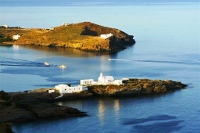 it is built on a rocky islet and cut off from the main island by a narrow strip of sea. It is an exceptionally quiet area scattered
with exquisite private villas (both old and newly built) as it is the choice of the financial elite, an area with the least
accommodation facilities on the island. There are only two tavernas and no other facilities than that. Chrysopigi has one of the
loveliest sandy beaches of the island (called Apokofto) although it is a popular swimming spot also for its turquoise pebble beaches
and its great flat sea side slabs of stone surrounding the monastery. From here one can take a walk to the quaint fishing village
of Faros, where you can find more beaches, few tavernas, coffee shops and a couple of mini market. Chrysopigi is 10 km away from
the capital village of the island (Apollonia), 15 km away from the port (Kamares) and 2 km away from the cosmopolitan beach of
Platy Yialos. Buses do not reach this idyllic beach so it is accessible only by car, scooter, taxis, etc.
it is built on a rocky islet and cut off from the main island by a narrow strip of sea. It is an exceptionally quiet area scattered
with exquisite private villas (both old and newly built) as it is the choice of the financial elite, an area with the least
accommodation facilities on the island. There are only two tavernas and no other facilities than that. Chrysopigi has one of the
loveliest sandy beaches of the island (called Apokofto) although it is a popular swimming spot also for its turquoise pebble beaches
and its great flat sea side slabs of stone surrounding the monastery. From here one can take a walk to the quaint fishing village
of Faros, where you can find more beaches, few tavernas, coffee shops and a couple of mini market. Chrysopigi is 10 km away from
the capital village of the island (Apollonia), 15 km away from the port (Kamares) and 2 km away from the cosmopolitan beach of
Platy Yialos. Buses do not reach this idyllic beach so it is accessible only by car, scooter, taxis, etc.
Some Sifnian Highlights:
- Hike to the top of Profit Elias for a view of the entire island of Sifnos.
- Explore the historical and fascinating village of Kastro and the ancient Acropolis here. There are two restaurants, a wonderful rocky beach you can climb down to called Eftamartyris, plus possibly the best bar on Sifnos Kavos Sunrise. I strongly recommend having an ouzo here! The owner/bartender is also a shepherd with a university degree in sociology, and the view is absolutely amazing. Also, Seralia at the bottom of Kastro has a great fish taverna right over the water.
- Spend a day on the beach in Vathi.
- Wander through the pedestrian paths of Apollonia, up to Artemonas - along the path on your left is Gregory's, arguably the best shop on Sifnos for traditional biscuits (cookies).
- Faros, a small fishing village, there is a short hiking trail to Chrysopigi, by far one of the most beautiful spots on Sifnos, and at Chrysopigi on the beach there are two wonderful tavernas for lunch. The trail follows the headland along the coast and offers views of the turquoise waters.
-
 There is a monastery named Poulati that is well worth a visit (it is
another hike, from Kastro) and at the bottom of it is a gorgeous rocky
beach for swimming, if you aren't afraid of steps.
There is a monastery named Poulati that is well worth a visit (it is
another hike, from Kastro) and at the bottom of it is a gorgeous rocky
beach for swimming, if you aren't afraid of steps.
The Ancient Acropolis [Citadel] at Agios Andreas:
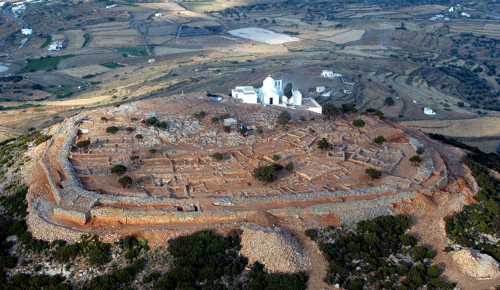
The most important archaeological site on Sifnos island
Archaeology lovers should definitely visit the Mycenaean Acropolis at Agios Andreas. The Acropolis lies on the top of a hill, known as the "Kastro tou Ai-Dria" (St. Andrew's Castle), and it located on the way from Apollonia to Vathi. Recent excavations brought to light a town that was built in the 13th Century B.C and was inhabited for a hundred years before being abandoned in the 12th Century B.C. It was once again occupied in the Geometric Era in the second half of the 8th century.
The inhabitants of that era were responsible for the later developments of the town. The town was naturally fortified by the steep hill that also allowed for an excellent view
 in case enemies were planning to attack and was further protected by the double fortification wall built around it. It was eventually abandoned in the 4th century B.C. Vessels and pottery from the different eras of habitation have also been unearthed exhibited in the small museum within the site. This archaeological site is one of the best examples of Mycenaean fortifications in the whole of Cyclades. The site and its museum are open from 08:30 to 15:00 daily, except Mondays and National Holidays. Next to the archaeological site is the beautiful church of Agios Andreas that offers breathtaking panoramic views of Sifnos island, the Aegean sea and the surrounding Cycladic islands.
in case enemies were planning to attack and was further protected by the double fortification wall built around it. It was eventually abandoned in the 4th century B.C. Vessels and pottery from the different eras of habitation have also been unearthed exhibited in the small museum within the site. This archaeological site is one of the best examples of Mycenaean fortifications in the whole of Cyclades. The site and its museum are open from 08:30 to 15:00 daily, except Mondays and National Holidays. Next to the archaeological site is the beautiful church of Agios Andreas that offers breathtaking panoramic views of Sifnos island, the Aegean sea and the surrounding Cycladic islands.
Panigiria or Festivals:
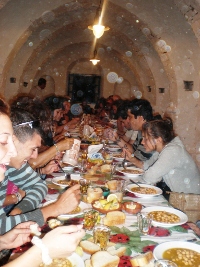 From
Visiting Sifnos during one of the island's many panigiria is a definite
bonus to those travellers seeking experiences with a true Greek flavour. A
"panigiri" is a traditional fiesta celebrating the name-day of a saint,
held in the church bearing the saint's name. To start there is church
service and mass, followed with a feast of traditional food and plenty of
local Sifnos wine. After eating comes the local music, accompanied by
singing and dancing, and this occasionally lasts until sunrise! The
churches most often hosting a panigiri are located in the mountains of
Sifnos away from the villages and the walking distances to reach them can
vary from one to two and a half hours. In general the festivals held in
the evenings have more of the "fiesta" atmosphere while those held in the
mornings tend to be of a more serious religious nature. However this does
vary so ask before each panigiri so that you know what to expect.
From
Visiting Sifnos during one of the island's many panigiria is a definite
bonus to those travellers seeking experiences with a true Greek flavour. A
"panigiri" is a traditional fiesta celebrating the name-day of a saint,
held in the church bearing the saint's name. To start there is church
service and mass, followed with a feast of traditional food and plenty of
local Sifnos wine. After eating comes the local music, accompanied by
singing and dancing, and this occasionally lasts until sunrise! The
churches most often hosting a panigiri are located in the mountains of
Sifnos away from the villages and the walking distances to reach them can
vary from one to two and a half hours. In general the festivals held in
the evenings have more of the "fiesta" atmosphere while those held in the
mornings tend to be of a more serious religious nature. However this does
vary so ask before each panigiri so that you know what to expect.
What makes these Sifnian festivals different in relation to similar ones found on the mainland and other Cycladic islands is the complete absence of commercial events. The expenses of each panigiri are undertaken by a different family of Sifnos every time. The family wishing to undertake this obligation must declare it on the day of the festival the year before. The expense of a panigiri ranges from 1,200€ to over 3,000€. This includes: the food, the wine, the musicians asked to participate in the festival (usually a violinist and a laouto player), the donation to the church, the fees for the priests, the fees of the church singer(s), and the expenses for maintaining the church and all the buildings that belong to it for the entire year.
All are welcome to attend this unique tradition found only on Sifnos, just bring a sturdy pair of walking shoes and a Zorba-esque flair for fun!
